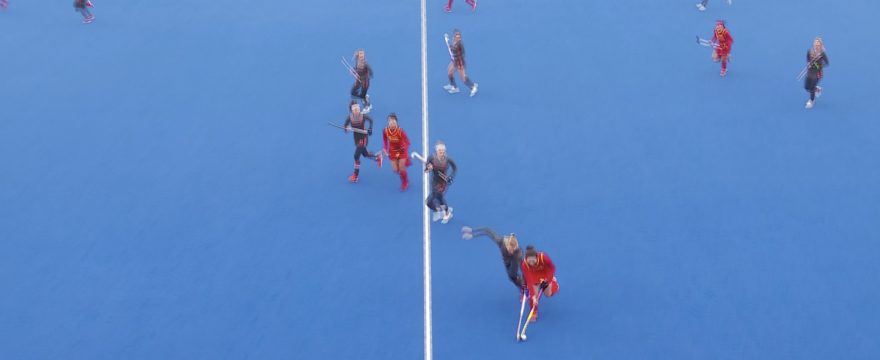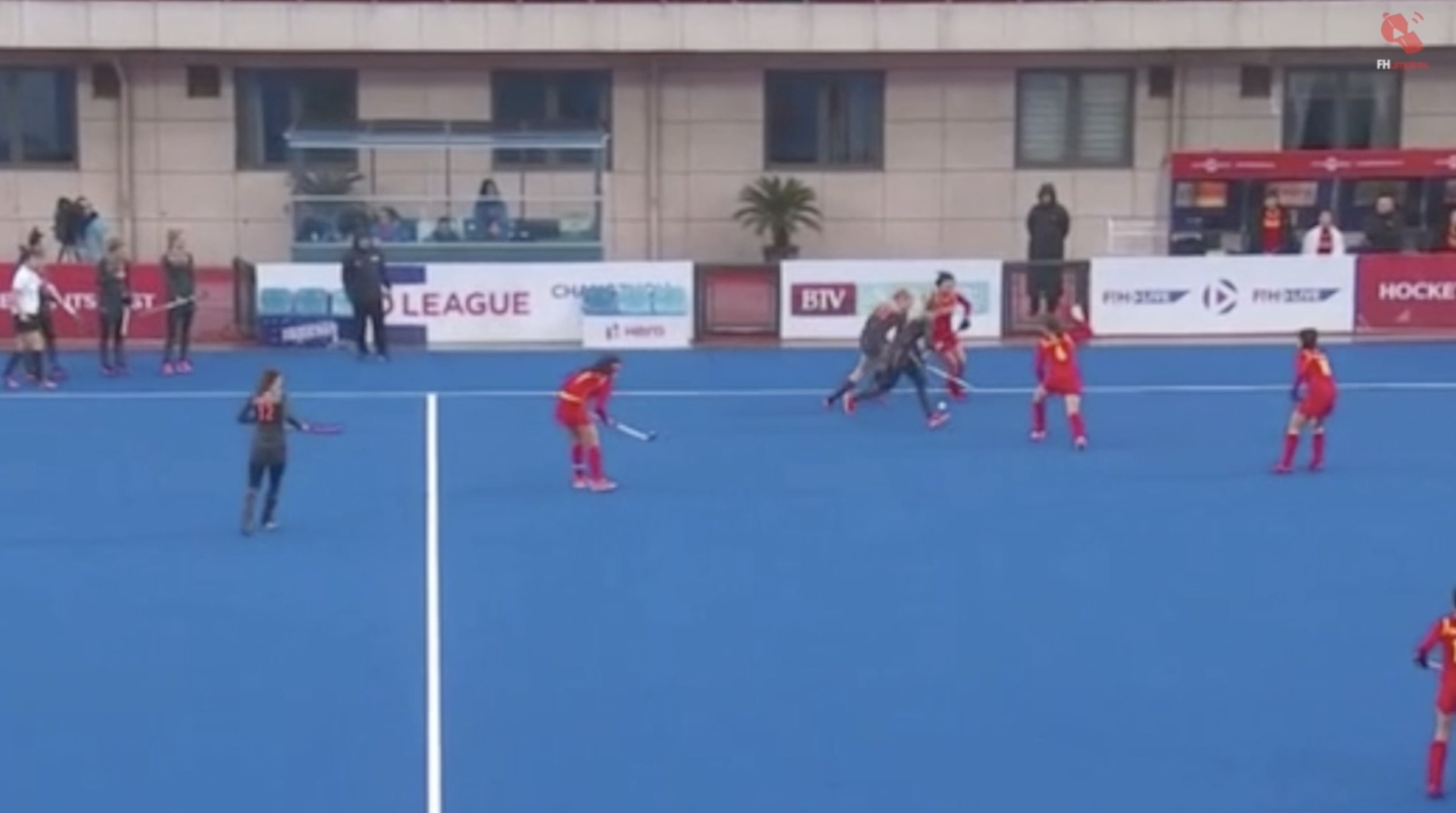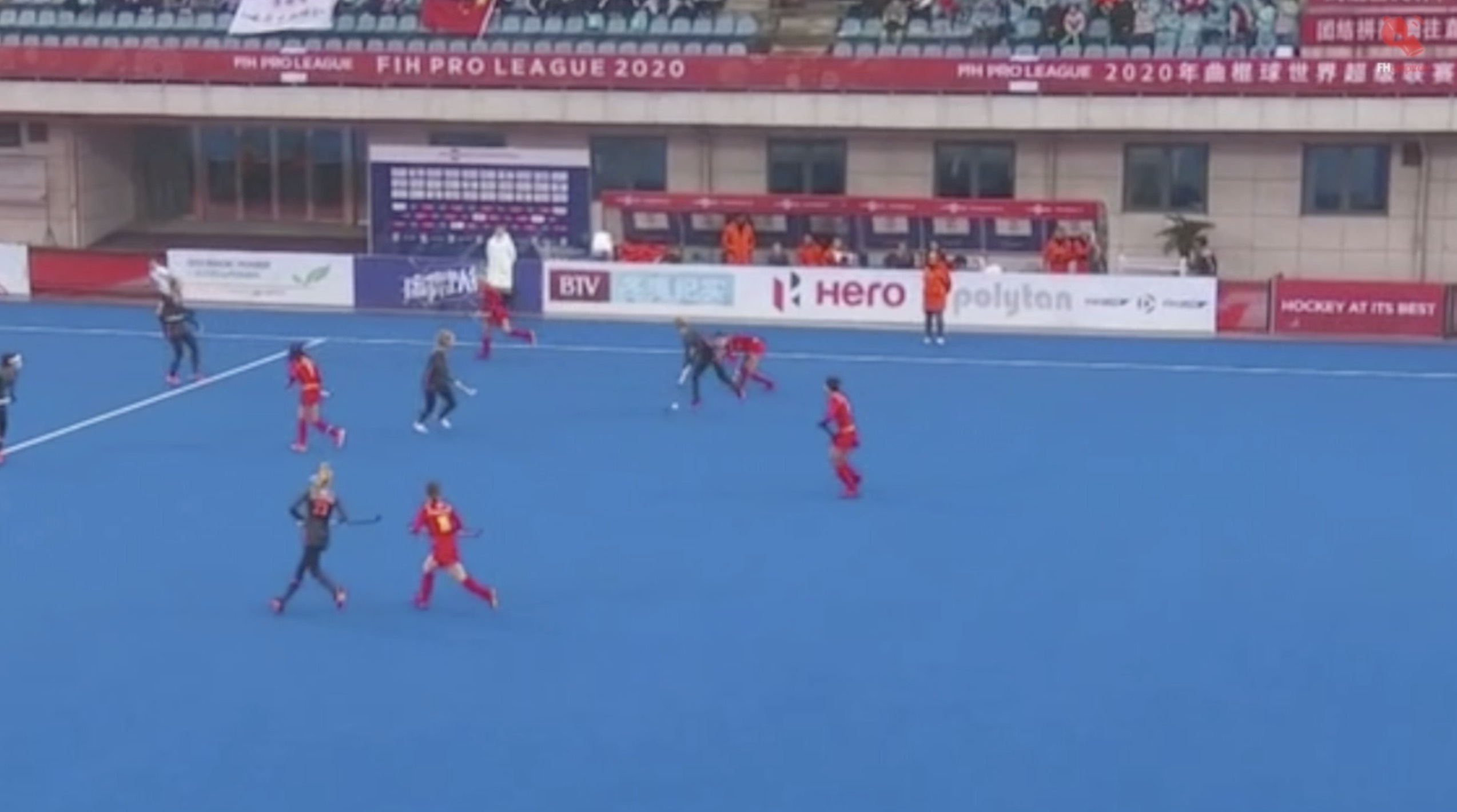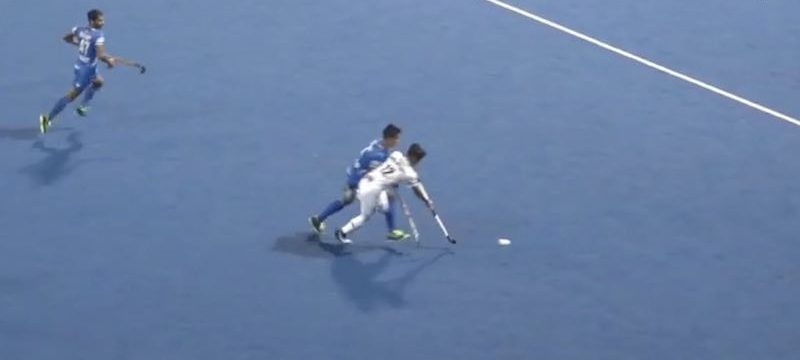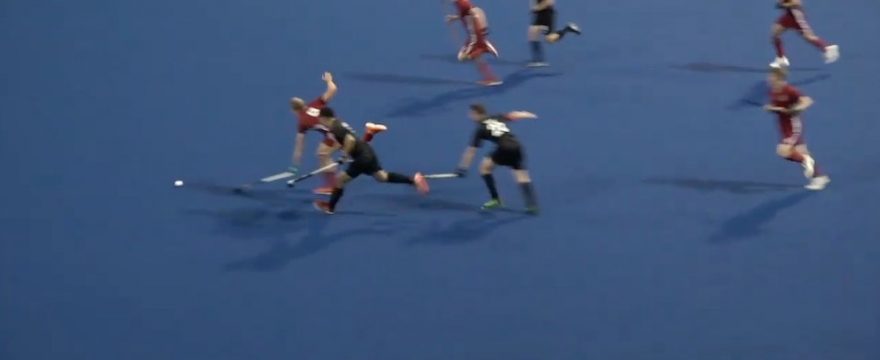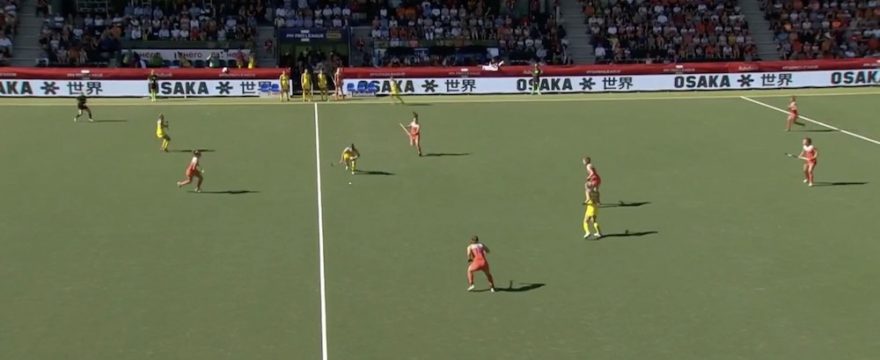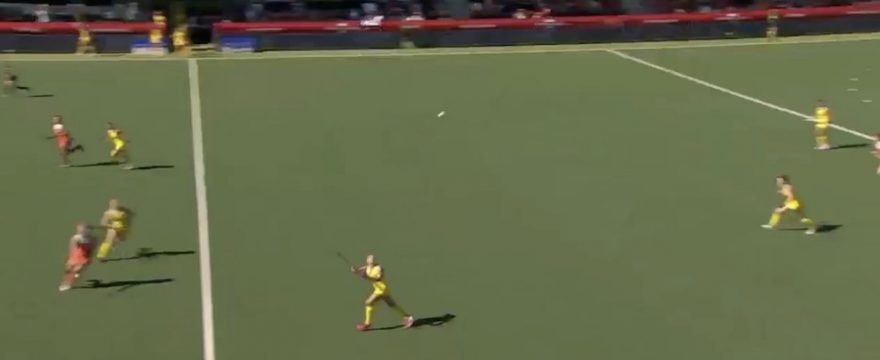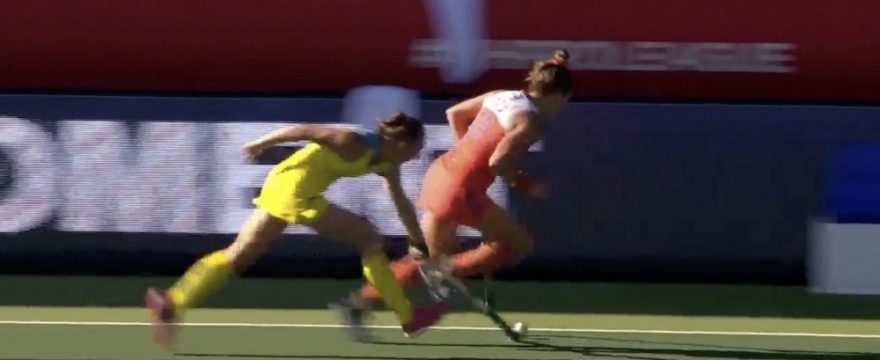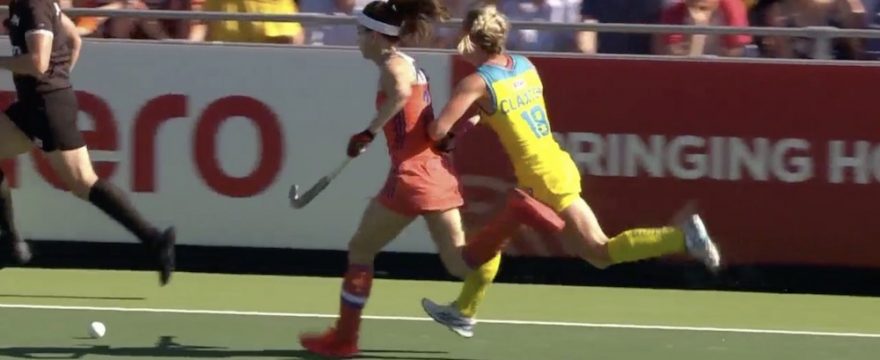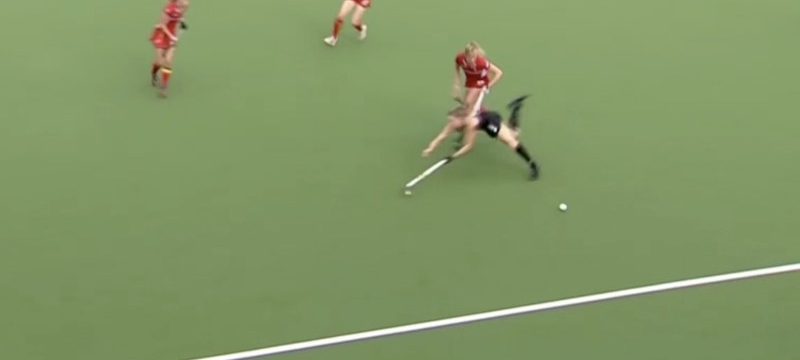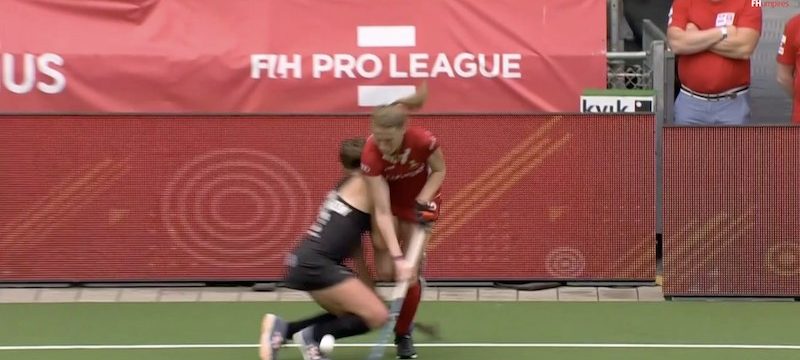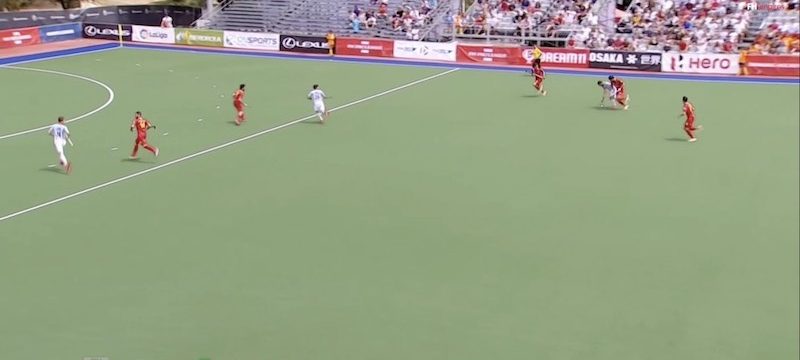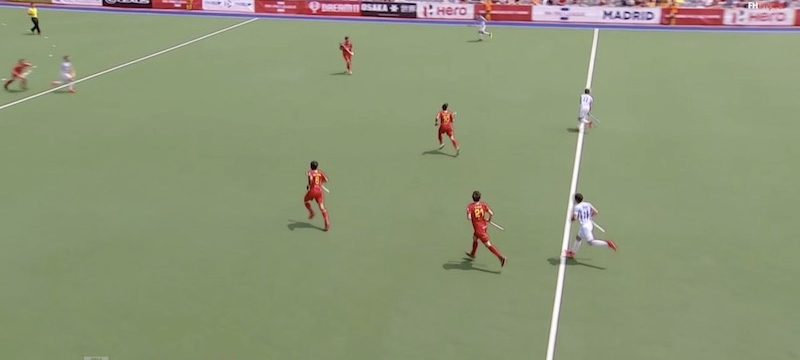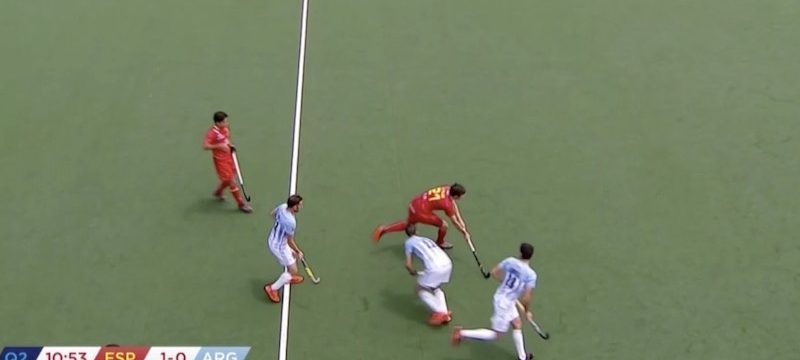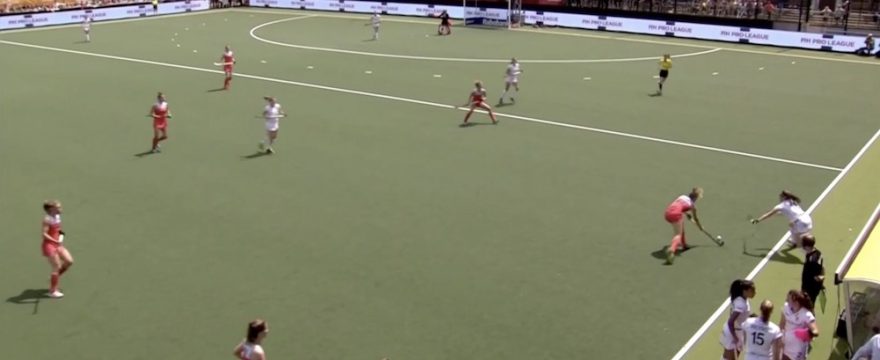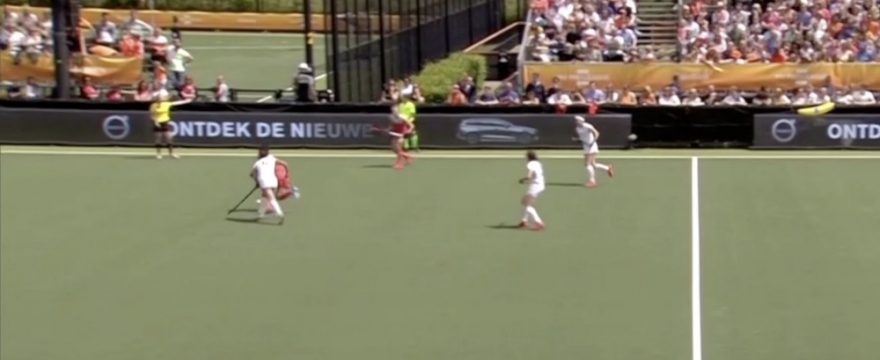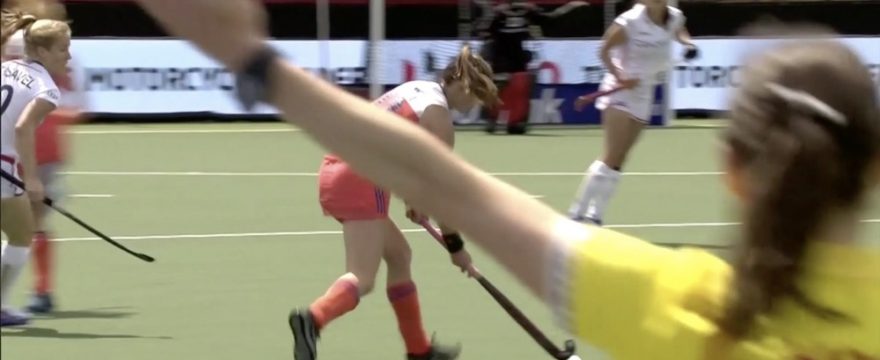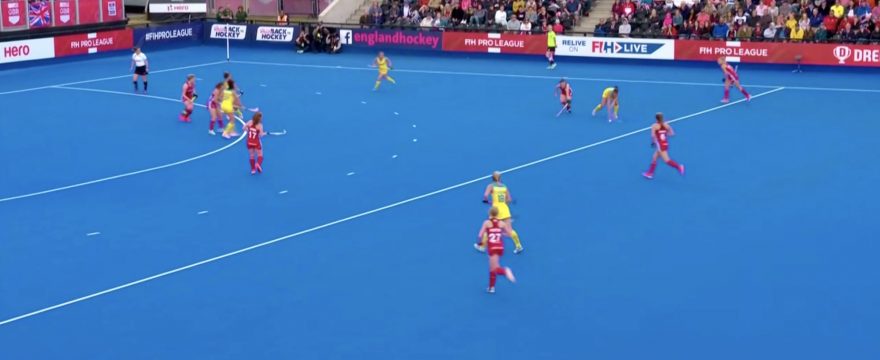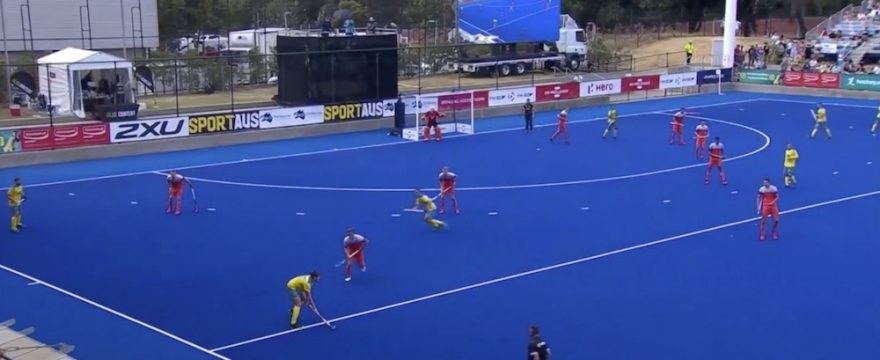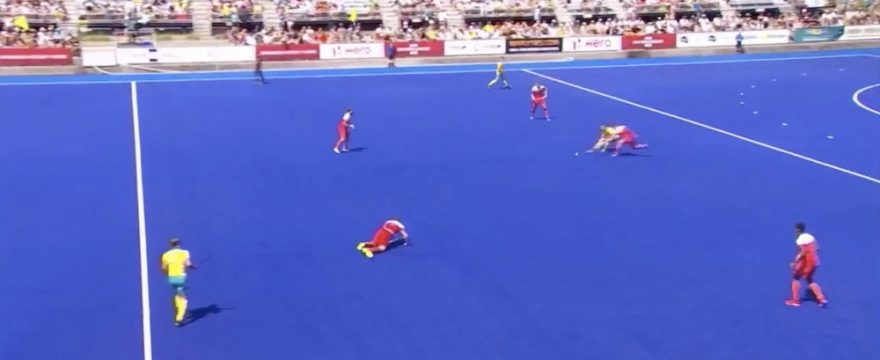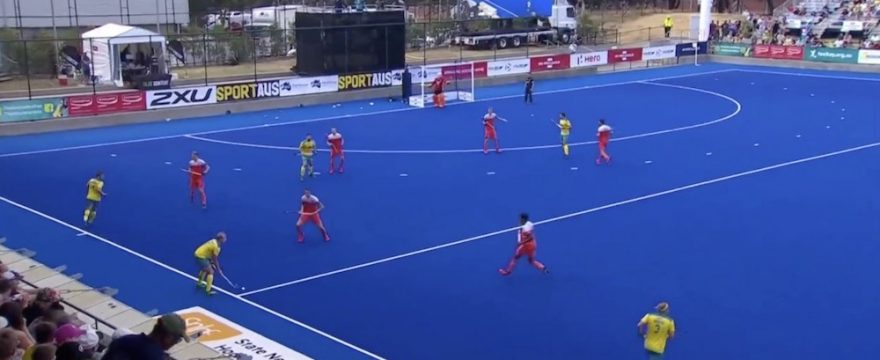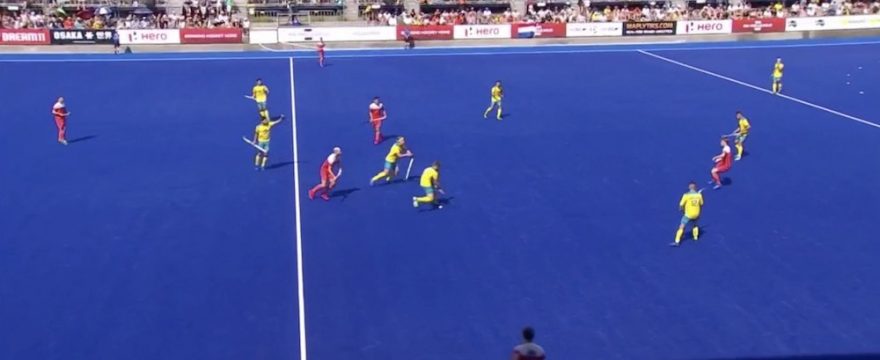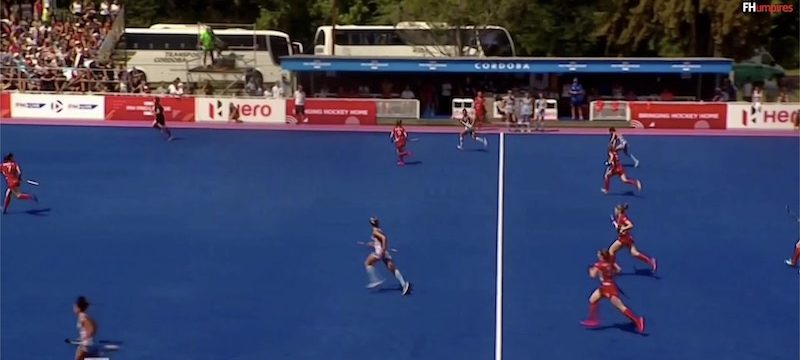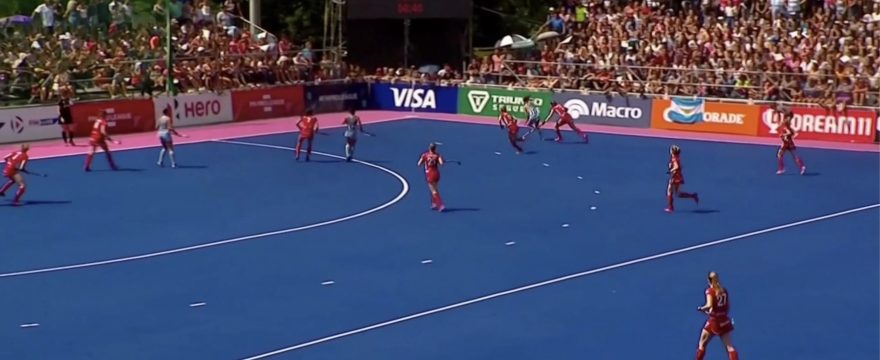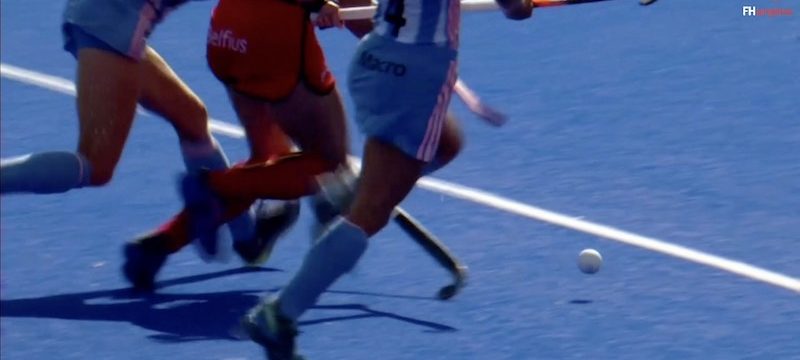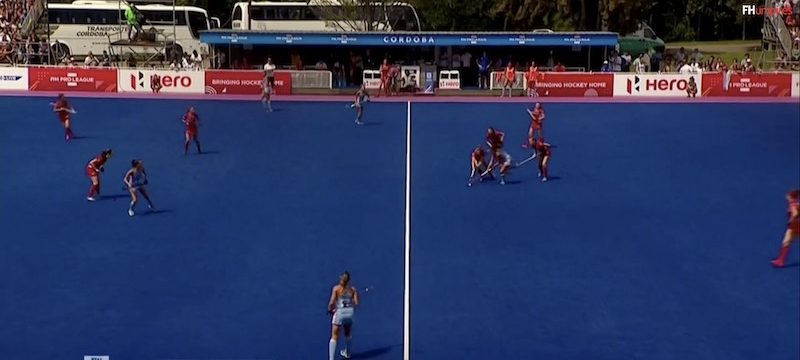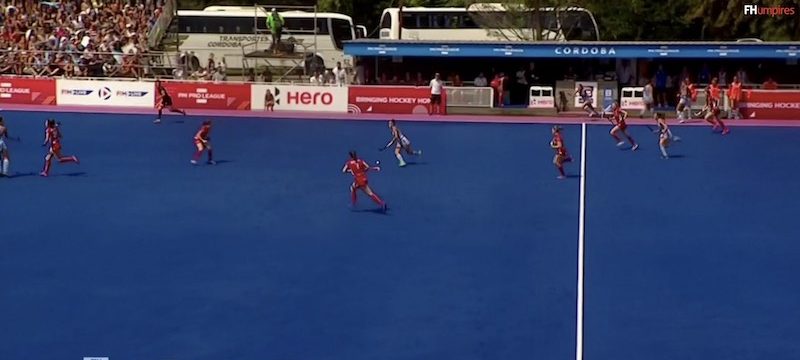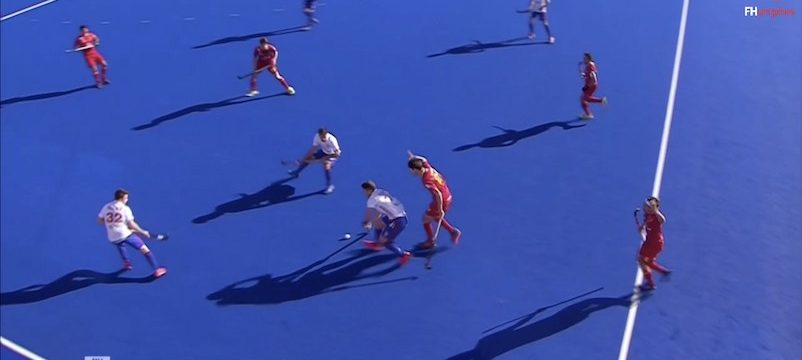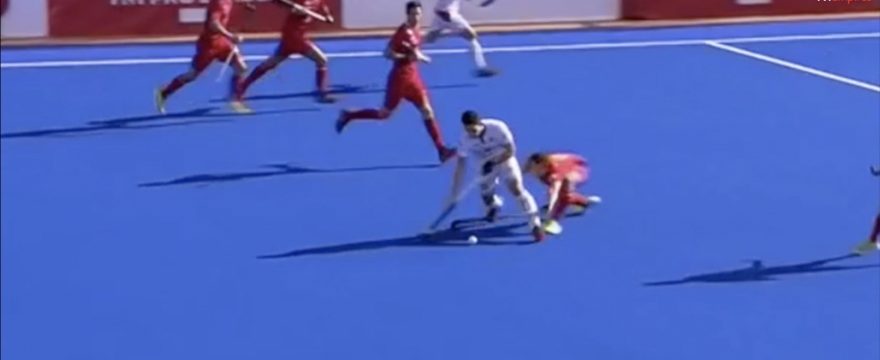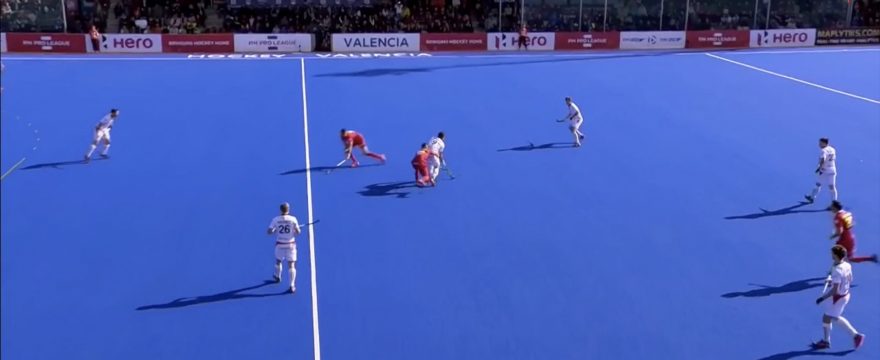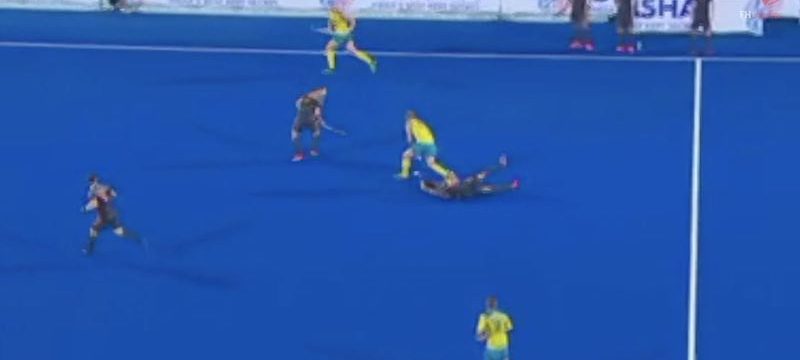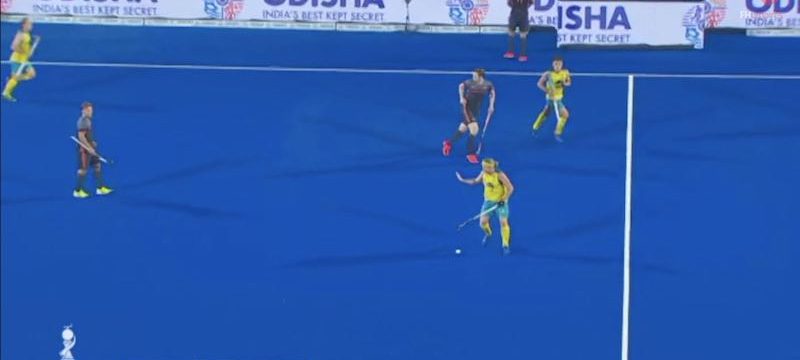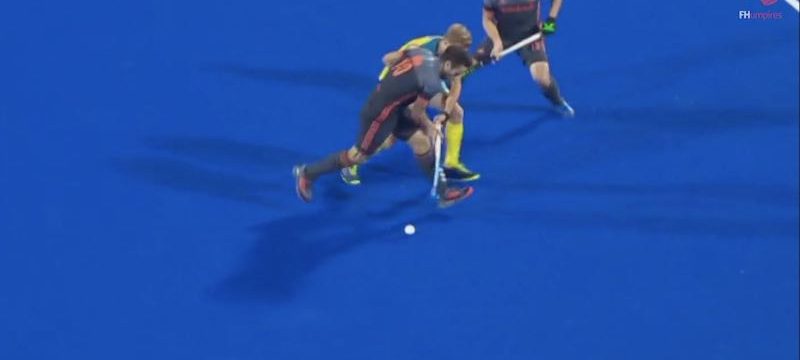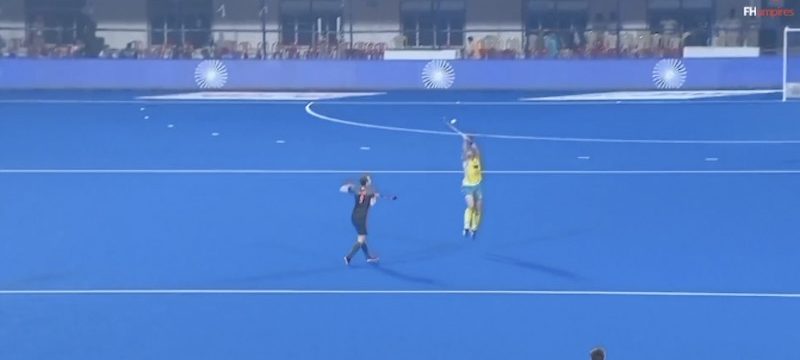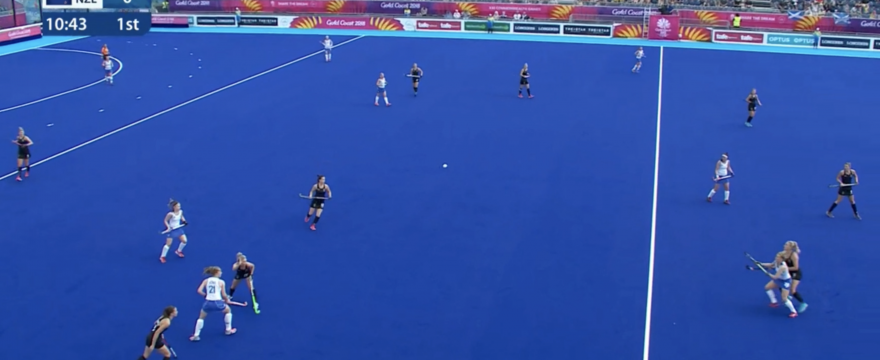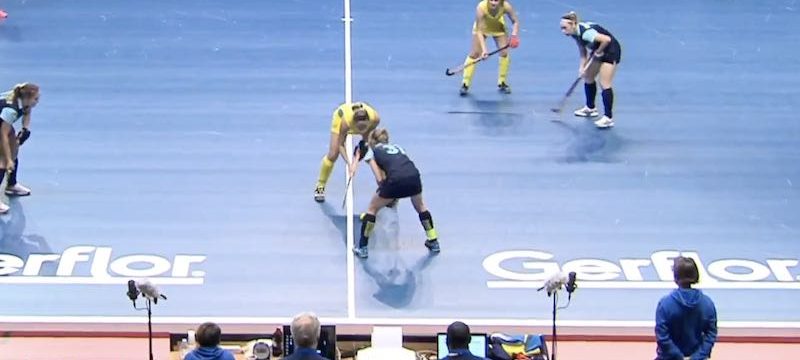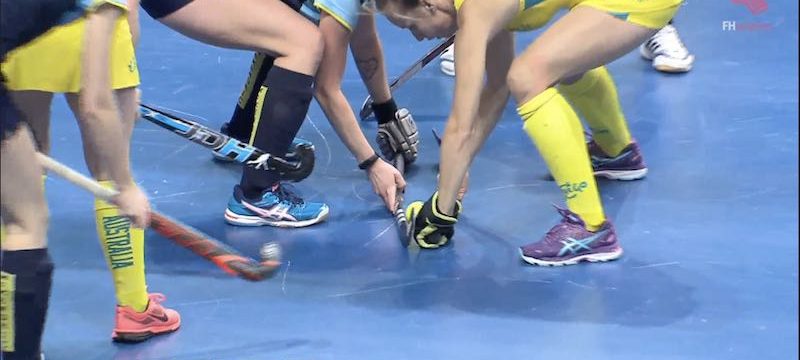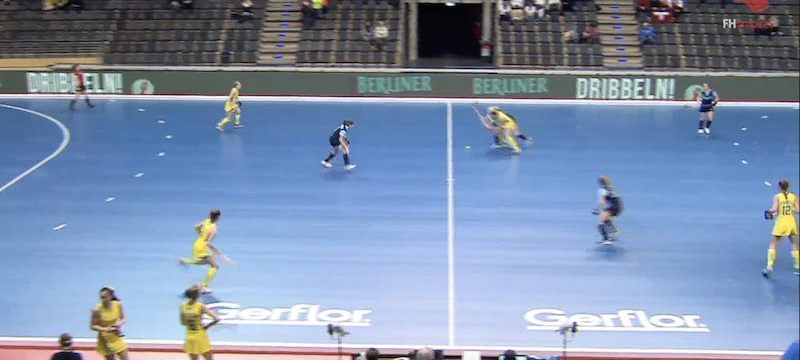The ball carrier receives the ball on the turn and moves to her left. Her dribble continues in that direction while she places her stick in between the ball at the tackler’s stick in a non-momentary …
CHNvNED GC playing ball after the whistle
At this level of play, a quick and subtle touch by the offending team after they’ve committed the foul and the whistle has gone can eliminate the chance for their opposition to take a quick free …
Continue Reading about CHNvNED GC playing ball after the whistle →
CHNvNED 5m infringement for GC
When NED turns over the ball on a foot foul, the CHN pass off the free hit is intercepted by a forward running back inside the 5m radius of the ball, resulting in a green card being shown. …
MASvIND Yellow card for stepping into running line of attacker
After a series of turnovers, the attacking team moves away at speed with the ball. A chasing defender clips the heels of the ball carrier, who is maintaining a straight line in his run (although there …
Continue Reading about MASvIND Yellow card for stepping into running line of attacker →
GBRvNZL Green card for breakdown after turnover of possession
Each time the ball is turned over, it’s important to prepare for the team who gave away possession to attempt to break the play down and allow their teammates a chance to get numbers and structure in …
Continue Reading about GBRvNZL Green card for breakdown after turnover of possession →
GBRvNZL Yellow card for breakdown
A yellow card for the 3rd breakdown by the same team in the match, now in Q3. Note the space available to the attacker behind the two defenders he’s beaten that he would have been able to burst …
GBRvNZL Yellow card for breakdown in Q4 stepping in with shoulder
Late in the game, the fouling team is up a single goal. After turning over the ball outside their 23m line, an attacker is able to beat a tackle. That tackler puts his shoulder in to interrupt the run …
Continue Reading about GBRvNZL Yellow card for breakdown in Q4 stepping in with shoulder →
NEDvAUS Turnover drill
It’s a small detail but makes a mammoth difference in the end positioning result. When the ball is turned over in the midfield, the umpire immediately turns to sprint hard towards her own circle. When …
NEDvAUS Opponent within 5m of initial receiver on aerial
As this aerial goes up, two opposing players may have been within 5m of each other in a receiving area. However, from where the ball is heading there is an initial receiver from the attacking team who …
Continue Reading about NEDvAUS Opponent within 5m of initial receiver on aerial →
NEDvAUS GC for breakdown play along sideline
After a turnover, a defender tracks the ball carrier up the near sideline and presumbly trips her up. Note that the side-on camera angle doesn’t show what we need to see, but from the umpire’s angle …
Continue Reading about NEDvAUS GC for breakdown play along sideline →
NEDvAUS GC advantage and communication
A green card is given after a short advantage is played through a transfer across to the other side of the pitch. The chasing defender beats the attacker to the ball and receives a little shove in the …
Continue Reading about NEDvAUS GC advantage and communication →
BELvNZL Two green cards in succession
Here two green cards are given in quick succession from two different ends of the spectrum. In the first instance, the defender was solidly in front of the ball carrier, attempted a vigorous poke …
Continue Reading about BELvNZL Two green cards in succession →
BELvNZL GC for stick obstruction breakdown
A defender is beaten to the ball and as she is beginning to fall off the pace, throws her stick in from behind and breaks down the play. This is a clear green card. To access this content, …
Continue Reading about BELvNZL GC for stick obstruction breakdown →
BELvNZL Breakdown worth a card?
Although the defender may not have planned to go to ground in this situation, was she sufficiently reckless with her body and presented enough danger for this stopping body obstruction that a card …
ESPvARG GC Breakdown body obstruction
After a turnover deep in the ARG defensive end, an unexpected amount of space has opened up after the ball crosses the centre line. Although the chasing defender has a teammate in front of the ball …
Continue Reading about ESPvARG GC Breakdown body obstruction →
ESPvARG Early read on the transition
The umpire on the far side recognises early the potential for an end to end counter and, being aware of the attacker high in the circle, moves quickly to get to his “happy place” behind the base line …
Continue Reading about ESPvARG Early read on the transition →
ESPvARG GC 5m free hit management
A stick obstruction is called and the fouling team attempts to take the free hit quickly. The umpire whistles the correction, and an attacker takes the self-pass quickly from the point of the initial …
NEDvBEL YC 3rd breakdown
This is the third breakdown foul by this team so far in the game, and the two previous had been met with green cards. However, the reason this seemingly innocuous stick tackle is penalized this …
NEDvBEL No advantage
This is an example of when possession isn’t accompanied by opportunity, so the better remedy is to blow your whistle. Although the ball carrier may have had the skill to dribble away from the …
NEDvBEL GC timing
Consider the timing of when you give cards. Although the foul itself was reckless it had no effect on the development of the play and the attacking team was in full possession with options available …
GBRvAUS GC breakdown stick tackle
A green card, the first of the game, is awarded for this tackle attempted from a risky position which breaks down the play. To access this content, you must purchase FHu3t Green, FHu3t …
GBRvAUS Back stick in midfield
A midfield pass is played off the back stick and called only for danger when the receiver tries to deflect it on dangerously into her marking defender. Watch for the speed of the swing and the lack of …
AUSvNED When the ball is played on a free hit
A 23m restart is taken with the smallest of dribbles, and although the taker draws it back to a stationary position before resuming his movement, has clearly initiated his self-pass. It’s important to …
Continue Reading about AUSvNED When the ball is played on a free hit →
AUSvNED Too high on backfield transfer
Your positioning on backfield possession transfers will have a big impact on your ability to handle turnovers. We have to read the style and intensity of the defending press and if it’s coming, …
Continue Reading about AUSvNED Too high on backfield transfer →
AUSvNED Sideline ball management
There are times when an imprecisely-placed sideline ball is no issue at all, and then there are times like this. It’s unclear to everyone, including the defender, as to whether the self-pass was taken …
AUSvNED GCx2 playing ball after whistle
Two instances within 45s of the same team playing the ball after the whistle and breaking down play. In both examples, the fouling player subtly moves the ball further away from the spot of the foul …
Continue Reading about AUSvNED GCx2 playing ball after whistle →
AUSvNED GC for breakdown tackle trip
A green card is awarded after a late stick trips up the ball carrier. To ensure you get this call right too, make sure you’re creating an angle off the sideline that keeps you from getting “caught in …
Continue Reading about AUSvNED GC for breakdown tackle trip →
ARGvBEL Transitioning from forward running to backpedalling
Although it’s ideal to be welcoming the play coming towards you from a relatively still position on the field, there will be times in fast, open games where the attack will move towards your end over …
Continue Reading about ARGvBEL Transitioning from forward running to backpedalling →
ARGvBEL Attack positioning with space
The attack begins well behind the centre line. As there are large channels for the ball to move through, the controlling umpire is very high up the pitch and close to their end line. The lack of …
Continue Reading about ARGvBEL Attack positioning with space →
ARGvBEL Breakdown tackle just outside 23m
As soon as the ball popped past the planted defender near the centre line there was always going to be a breakdown tackle to stop this threatening run down the middle of the field. Note the exact spot …
Continue Reading about ARGvBEL Breakdown tackle just outside 23m →
ARGvBEL Quick Whistle To Eliminate Defenders
Whistle timing is a critical tool in an umpire’s arsenal to create more flowing, attacking hockey. Here the stick obstruction occurs when the ball carrier has three defenders converging on her. While …
Continue Reading about ARGvBEL Quick Whistle To Eliminate Defenders →
ARGvBEL Reading attacking play
Preferred positioning has the controlling umpire well ahead of the play, turned to face the attack as it transitions into the 23m area and from an inside angle. In order to get to this spot, umpires …
ESPvGBR Aerial for attack and ball placement
The attacker is the initial receiver of this outlet aerial, and two defenders encroach on the 5m area. The first freeze frame is the moment when the free hit is awarded; the second where the self-pass …
Continue Reading about ESPvGBR Aerial for attack and ball placement →
ESPvBEL Body shield or not?
Amazingly difficult clip to determine whether there was any kind of shield or not. The ball carrier’s stick didn’t come over the ball to shield, but was the ball dropped behind his leg in order to …
ESPvBEL Warning for arm on back breakdown
After a vigorous challenge comes in from ESP #14, you can hear the umpires talking over the radio to confirm who it was and how they agreed they would deal with it, which was by a verbal warning. The …
Continue Reading about ESPvBEL Warning for arm on back breakdown →
AUSvNED Clean tackle from behind
Although it’s rare, it is possible for players to make successful and clean tackles from behind their opposition. It’s important to make no assumptions and focus on the defender’s stick and body to …
AUSvNED GC breakdown tackle from ground
A defender attempts a tackle from a poor position in behind and interferes with the ball carrier with their arm or stick. Although the defender is on the ground, they haven’t met the criterion for an …
Continue Reading about AUSvNED GC breakdown tackle from ground →
AUSvNED Playing ball after whistle warning
This is the first time a player has played the ball after the whistle in this game but, given the number of seconds left in the half, the effectiveness of this misconduct to prevent any last-second …
Continue Reading about AUSvNED Playing ball after whistle warning →
AUSvNED YC breakdown second card
This is the second card of the game for this player, who badly misses on this tackle and ensures his body stops the potential progress of the attacker to resume his run with the ball. Normally …
AUSvNED Aerial interception outside 23m for goal
An aerial ball is outlet from the left sideline on the diagonal into the middle of the pitch. From the side angle, it appears that the AUS player infringes within 5m of the NED player standing …
Continue Reading about AUSvNED Aerial interception outside 23m for goal →
SCOvNZL Free Hit Reset Timing
The first step in our Free Hit Drill is to locate the spot of the foul. If the ball moves away, we can proactively communicate with the players and let them know where we need the free hit taken from …
UKRvAUS Foul on the bully no flat side
The AUS player fails to both start her stick on the ground as required in 6.5(a), but also fails to tap her stick against her opponent’s with the flat side over the ball (it appears to be either the …
Continue Reading about UKRvAUS Foul on the bully no flat side →
UKRvAUS Trap for bully
The ball carrier dribbles into trouble and ends up in a stalemate with one opposing defender. When the ball doesn’t move, the umpire calls a bully for the no-fault obstruction and it takes two tries …
UKRvAUS Trapped ball on board for FP
When the ball carrier gets caught without many options on the right side-board, she eventually pushes the ball into the defending player's stick and causes the trapped ball obstruction, resulting in a …
Continue Reading about UKRvAUS Trapped ball on board for FP →
UKRvAUS GC dangerous use of stick
The offensive player is obstructed initially when the defender comes over the top of her stick in an attempted tackle. However, she uses her stick to move the defender’s stick away in a dangerous …
